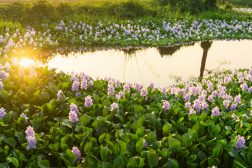plum
A knot; a cluster; a group; a crowd; a flock; as, a plump of trees, fowls, or spears. To visit islands and the plumps of men. (Chapman)
1. (Science: botany) The edible drupaceous fruit of the prunus domestica, and of several other species of Prunus; also, the tree itself, usually called plum tree. The bullace, the damson, and the numerous varieties of plum, of our gardens, although growing into thornless trees, are believed to be varieties of the blackthorn, produced by long cultivation. (G. Bentham)
Two or three hundred varieties of plums derived from the prunus domestica are described; among them the greengage, the Orleans, the purple gage, or Reine claude Violette, and the german prune, are some of the best known.
Among the true plums are; beach plum, the prunus maritima, and its crimson or purple globular drupes, bullace plum. See Bullace. Chickasaw plum, the American Prunus Chicasa, and its round red drupes. Orleans plum, a dark reddish purple plum of medium size, much grown in England for sale in the markets. Wild plum of America, Prunus Americana, with red or yellow fruit, the original of the Iowa plum and several other varieties. Among plants called plum, but of other genera than Prunus, are; Australian plum, Cargillia arborea and C. Australis, of the same family with the persimmon. Blood plum, the west african Haematostaphes Barteri. Cocoa plum, the Spanish nectarine. See Nectarine. Date plum. See Date. Gingerbread plum, the West African Parinarium macrophyllum. Gopher plum, the ogeechee lime. Gray plum, guinea plum. See Guinea. Indian plum, several species of Flacourtia.
2. A grape dried in the sun; a raisin.
3. A handsome fortune or property; formerly, in cant language, the sum of ?100,000 sterling; also, the person possessing it. Plum bird, Plum budder, an American weevil which is very destructive to plums, nectarines cherries, and many other stone fruits. It lays its eggs in crescent-shaped incisions made with its jaws. The larva lives upon the pulp around the stone.
Synonym: turk, and plum curculio.
Origin: AS.plume, fr. L. Prunum; akin to Gr, . Cf. Prune a dried plum.
Dictionary > Plums
You will also like...

Mammalian Ancestors
Mammals are a diverse group of organisms, where most of them develop their offspring within the uterus of the mother. Ov..

Still Water Community Plants
This tutorial looks at the adaptations of freshwater plants for them to thrive in still water habitats. Familiarize your..

Movement of Molecules Across Cell Membranes
Molecules move within the cell or from one cell to another through different strategies. Transport may be in the form of..

The Central Nervous System
Myelin sheath is essential for a faster conductivity of signals. Know more about this feature of some neurons in the Cen..

Plant Tissues
Plant organs are comprised of tissues working together for a common function. The different types of plant tissues are m..

Temperature Regulation in Animals
This tutorial elucidates body temperature regulation. Know the details here to learn how the body sets the body temperat..

